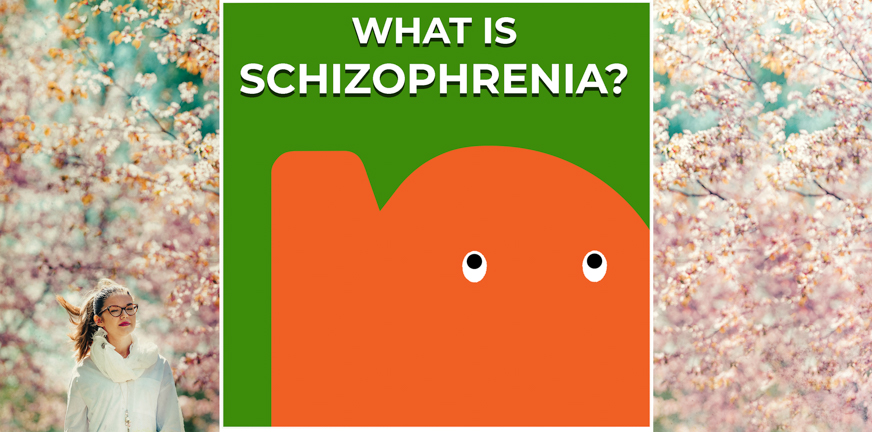
Many insights we had about schizophrenia have by now been proven wrong. Yet these outdated ideas are still spread around. So what is schizophrenia really? What are we talking about when discussing it? And what does it mean to be diagnosed with schizophrenia?
What is schizophrenia?
Have you ever looked for information on schizophrenia? Then you’ve probably found that it’s a very serious psychiatric disease. Maybe you’ve also read that it’s about having a split personality (multiple personality syndrome) and that people with schizophrenia are dangerous and untrustworthy. These ideas have long been proven wrong, yet are still spread around. Why is that?
The history of schizophrenia
The term ‘schizophrenia’ was first introduced in 1908 by the Swiss psychiatrist Eugen Bleuler. The word schizophrenia’ comes from the Greek words schizein (split, or divided) and fren (mind). And thus the word can be roughly translated as ‘divided mind’.
When Bleuler introduced this term to describe psychotic symptoms, he wanted to point out that schizophrenia means a division between the different functions of the mind. The ‘divided mind’ thus refers to the functions memory, thought, and perception. It is not about having multiple personalities.
Dementia praecox: schizophrenia as early dementia
Psychiatrist Emil Kraepelin spoke already in 1893 of dementia praecox (early dementia) to describe his psychotic patients. He thought that dementia praecox was a brain disease quite similar to Alzheimer’s disease (dementia). One that could occur at a much younger age.
Bleuler changed his mind about this schizophrenia as a form of Alzheimer’s after noticing that some patients actually recovered instead of getting worse. This never happened with dementia patients, so it clearly had to be an entirely different disease. He therefore came with the new name: schizophrenia.
Schizophrenia as diagnosis in the DSM
The Diagnostic and Statistical Manual of Mental Disorders (or DSM, the most common system of diagnosis and classification of mental disorders) roughly describes schizophrenia as a disorder characterized by psychotic episodes ‘in which the patient loses the ability to test and confirm his sense of reality.’
The downside of the DSM
The DSM was once meant as a practical tool for doctors and psychiatrists. It ensured they spoke the same language when discussing their patients’ complaints and symptoms. Before the introduction of the DSM, around 60 years ago, every psychiatrist used his own definition. This sometimes lead to great confusion. Because, was a particular patient either psychotic, neurotic, or hysteric? And what was the exact meaning of these definitions?
From the very start, it was clear that the DSM diagnoses should not be seen as fixed diseases, but more as agreed-upon descriptions and concepts. But nonetheless, the DSM is increasingly used and presented in the wrong way.
‘The DSM says it, so it must be true’
To assume that a certain disease exists just because it is described in the DSM, is a huge error. This is not how the diagnostic descriptions were meant to be used. They simply were a tool and an aid in the treatment of a spectrum that was much more complicated than a single word (or description) could ever express.
The underlying issue is that mental disorders are much harder to connect to one single cause. This is different from physical healthcare. When you have a broken leg, the problem can be perfectly described by a standard diagnosis. You check a number of related symptoms and then conclude: the leg bone is broken. The treatment that follows from this diagnosis is also much clearer. A few weeks in a plaster cast, followed by rehabilitation exercises, and you’re guaranteed to recover.
All this is much more complicated and less straightforward with mental diseases. Not only do they vary much more from person to person, they are also much more vague and harder to describe. Moreover, there is much more uncertainty about the exact cause(s) of the symptoms, which mostly involves multiple factors. The exact causes vary greatly among patients, and so does the way in which they experience their symptoms. Consequently, a mental disorder must be investigated per individual case. And effective treatment should be based on the person instead of on the disease.
What kind of treatment would work, can vary strongly between people. For instance, some schizophrenia patients respond very well to trauma treatment. Others should first get proper housing and a stable lifestyle before they are even ready to start treatment. Standard solutions only work for standard problems, but not for psychological problems, which are always extremely personal and cannot be understood without looking at the context in which these problems have arisen.
Schizophrenia is no clearly defined disease
The DSM-5 clearly warns us that we should not regard schizophrenia as an objective disease with a fixed description. That’s impossible, because the criteria for the schizophrenia diagnosis change with every new edition of the DSM. And every international system of disease classification has its own criteria for recognizing schizophrenia.
Until 2013, people recognized five different subtypes of schizophrenia: the paranoid, disorganized, catatonic, undifferentiated and residual type. By now, psychological scientists agree that there are no clear differences between these five subtypes. And thus they have been removed from the latest version of the DSM. Instead, schizophrenia is now discussed in terms of a schizophrenia spectrum.
Read more about the schizophrenia spectrum




